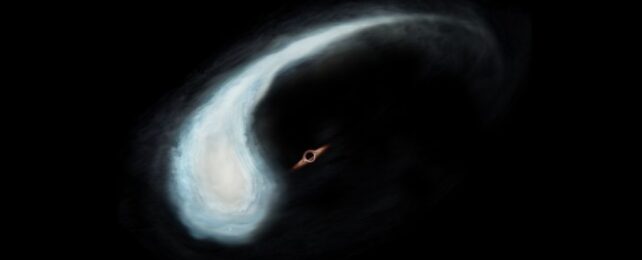A comma-shaped molecular cloud near the center of the Milky Way seems to be orbiting one of the most sought-after objects in astronomy.
At the center of the "Tadpole's" orbit, a team of astronomers saw precisely … nothing. And a nothing which attracts something simply screams ' black hole'.
Modeling suggests that this wouldn't just be any run-of-the-mill black hole either, but one belonging to the rarely-seen class of middleweights; the "missing link" intermediate-mass black holes.
If this is the case, it would be the fifth candidate intermediate black hole found near the galactic center.
This growing number of heretofore elusive objects could help astronomers figure out how the supermassive black holes at the centers of galaxies form, and then grow to such colossal size.
"In this paper, we report the discovery of an isolated, peculiar compact cloud," write a team of astronomers led by Miyuki Kaneko of Keio University in Japan.
"The spatial compactness of the Tadpole and absence of bright counterparts in other wavelengths indicate that the object could be an intermediate-mass black hole."
Black holes in the Universe tend to be found in two distinct mass regimes. There are the stellar-mass black holes, up to around 100 times the mass of the Sun. These are black holes that form from the core collapse of a massive star at the end of its life, or mergers between such black holes.
Then there are the supermassive black holes. These are the giant chonkers that sit in the centers of galaxies, with masses millions to billions of times that of the Sun.
It's unclear how these objects form, and that's a cosmic conundrum that astronomers would love to resolve.
One place answers might be found is among black holes with in-between masses. Finding these intermediate-mass black holes (IMBH) would be evidence that black holes evenly span an entire range of masses, and that the intermediate ones are a stage of growth between titch and behemoth.
But only a scant few of these middleweight objects have been identified, and for the most part only tentatively.
One of the problems is that lone black holes don't emit any light on their own. They can only be detected by the effect their immense gravity has on their environment, causing matter to swirl in a white-hot rage, or by pulling on the fabric of space-time in distinctive ways.
This non-subtle tug can affect the orbital dance of distant objects, such as the stars astronomers studied to verify the presence of Sagittarius A*, the black hole at the center of the Milky Way.
The galactic center is a pretty packed place, actually. It's thick with molecular clouds, the kind that give birth to stars. It's known as the Central Molecular Zone, and its molecular gas density is several orders of magnitude higher than the disk of the Milky Way.
Because the region is so dense, it can be hard to see what's inside, but a powerful radio telescope can reveal the activity therein.
This is how the researchers found the cloud they nicknamed the Tadpole. They were using the James Clerk Maxwell Telescope to look for gas that has been perturbed by gravity.
The Tadpole was it: a molecular cloud very close to the galactic center, 27,000 light-years from Earth, moving differently from the other material nearby.
Its stretched-out shape, the team found, was likely the result of being pulled by the strong tidal force – a gravitational interaction.
And their modeling showed that the mass responsible for that interaction is around 100,000 times the mass of the Sun. That strongly suggests an intermediate black hole.
Where it could have come from, and how it formed, are questions that will remain to be answered.
First, the team needs to confirm their suspicions. They intend to use the powerful Atacama Large Millimeter/submillimeter Array in Chile to conduct follow-up observations of the Tadpole to determine if they can find signs of a black hole, or something else, at the orbital center.
If it does turn out to be an intermediate-mass black hole, that could have profound implications for our understanding of the supermassive variety.
The research has been published in The Astrophysical Journal.
